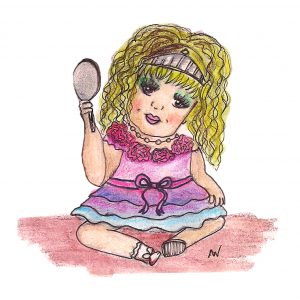
And high heels, and spray tans…
FAKE NAILS, FAKE eyelashes, fake tan, five-year-old girl. One of these things is not like the other, and it doesn’t take a rocket scientist to discern which does not belong.
Last week, a co-worker and I sat down to watch an episode of TLC’s hit show Toddlers and Tiaras. The documentary-style series follows little girls and their families—who typically hail from the American Deep South—as they prepare for and participate in beauty pageants.
Others in the office walked by with arched eyebrows and shot us looks of contempt, but we couldn’t tear our eyes away from the controversial show. It was like the proverbial train wreck: Looking made us feel sick to our stomachs, but turning away meant never knowing the answers to our many questions.
Would that mother actually take her 14-month-old infant to the nail salon for a set of acrylics and a French manicure? Would the pageant coach convince the parents to spray tan their three-year-old daughter? Would the judges of the competition look kindly upon the seven-year-old girl’s padded bikini top?
Our shock and horror resulted in an insatiable desire to find out what would happen next—not only in the episode, but also in the rest of the young girls’ lives.
Judging from what I’ve witnessed on a few episodes of Toddlers and Tiaras, it seems most child beauty pageants require the contestants to parade around in evening wear, “talent” costumes, and bathing suits. Watching two-year-olds waddle across a stage in frilly bikinis begs the question: What could the judges possibly be scoring the toddlers on? I can’t seem to divine an answer that does not make my skin crawl.
Perhaps the most disturbing component of beauty pageants are the titles awarded to the contenders. In almost all of the episodes of Toddlers and Tiaras I’ve seen, one little girl is crowned “Most Beautiful,” while the so-called “less-beautiful” children burst into tears.
I’m not naive. I know people judge each other based on appearances and I’m aware this will probably never change; however, I can’t help but wonder why a parent would not want to shield their child from this harsh reality for as long as humanly possible. Why would a mother or a father choose to prematurely introduce their daughter to the idea that beautiful people are “winners”? Once again, I find myself unable to come up with any good answers.
As a child, I played with Barbies, wore Sleeping Beauty pyjamas, and experimented with makeup. It could be argued my participation in these activities sexualized me at an age when I could barely pronounce the names of my own reproductive organs, but I managed to become a capable adult with a healthy level of self-esteem and the ability to understand my worth as a person is not tied up in my physical appearance.
That’s not to say I don’t struggle with self-acceptance—I am human, after all—but I feel confident if one were to measure the number of negative thoughts I have about myself, she or he would find me to be a relatively well-adjusted individual.
I fear the young pageant participants will have a much more difficult time learning to accept themselves than the average North American does. It seems a snowball has a better chance in hell than pageant princesses—or, in much rarer cases, princes—have of growing up to become healthy and happy adults. Having been raised surrounded by people who place so much emphasis on facial and physical beauty, these youngsters know no other worldly currency than their looks.
—Kristyn Filip






